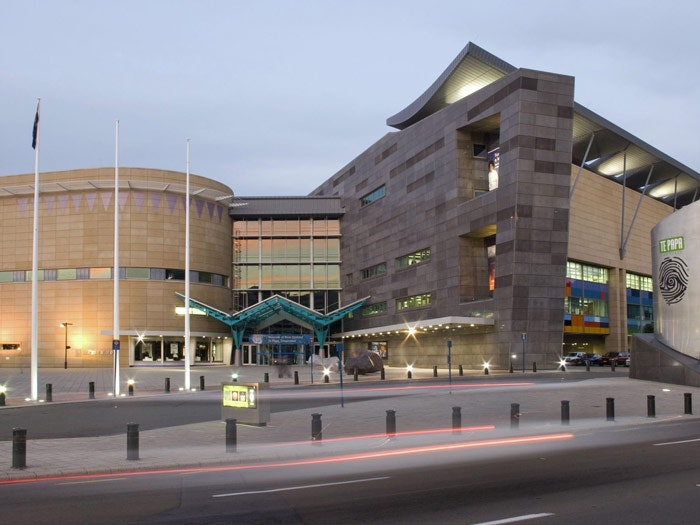Colour is a life-force
The artwork consists of an arrangement of coloured glass panels – called spandrels, by the artist – which together form a huge abstract composition. The work has a rhythm and energy that can shift as you’re moving past it, in different weather conditions, or at different times of day. Mrkusich was an abstract painter with a deep and enduring passion for colour. He said of these panels: ‘…colour is a life-force, I think. Some people are trying to read things into it, saying it’s a landscape or this or that, but it’s the resonance and energy of colour.’1
Making the spandrels
The work was commissioned from Mrkusich in 1994, during the construction of Te Papa’s building. Mrkusich was selected from a group of 11 artists and designers who had all been invited to propose an artwork for the building’s façade. He talked later about the challenge of working to such a specific brief, with very strict parameters. But as a painter who had spent much of his life exploring the possibilities of abstraction and colour, Mrkusich felt that he was equipped to make something meaningful for the site.2 After his design was approved, the enamel-on-glass panels were manufactured at Pilkington’s factory in Mount Wellington. They were made using coloured inks that were fused onto the interior surface of the glass. Mrkusich was very particular about achieving the exact right colour for each panel.3
Installing the glass panels when Te Papa was under construction. Photo by Michael Hall. Te Papa (MA_F.002954)
Milan Mrkusich
Milan Mrkusich was born in Dargaville in 1925. After attending high school in Auckland, he took an apprenticeship in Writing and Pictorial Arts at Neuline Studios and enrolled in the commercial art course at Seddon Memorial Technical College. From early in his career Mrkusich was deeply interested in European modernism and the Bauhaus movement. He began to explore the links that could be made between modern art and life through architecture, design and painting.
In 1946 – and countering the contemporary fashion for landscape painting – Mrkusich began to move towards abstraction in his painting. His works started to explore geometry and the structure of the grid. He increasingly focused on the application of paint, surface texture, and colour.
Art and design
At the same time, Mrkusich was also developing his practice as a designer. In 1949 he co-founded the architecture and design firm Brenner Associates. He worked for Brenner until it closed in 1958, producing influential interior and house designs, and acting as a colour consultant. There was a close connection between Mrkusich’s design work and his painting. As his Brenner co-director, Desmond Mullen, put it: ‘For the vast majority of the time he continued his painting as a sort of home exercise… I never saw him do any paintings in the office. But it was obvious that while physically he kept the two activities separate, in reality they were so closely related in his brain that from this distance looking back they were indistinguishable.’4
Colour and form
After Brenner closed in 1958 Mrkusich continued to work as an artist, deepening his investigation of geometric form and the effects of colour. In the ‘Diagram’ series of the late 1960s he pushed the shapes of circles and squares to the very edges of the canvas, leaving a large ‘field’ of textural colour at its centre. In the late 1990s ‘Colour / Achromatic’ works, Mrkusich painted small groups of canvases, each one a long grid of colour. These groups of panel paintings were hung together to form single works, not unlike the way that two coloured grids of glass panels come together as a single work on Te Papa’s façade. In all of these sets of work we can Mrkusich’s long-standing interest in the relationship between art and life, as well as the symbolic and transcendent power of colour.
Detail of Te Papa Tongarewa showing the spandrels, 2006. Photo by Michael Hall. Te Papa (156571)
[1] Quoted in Helen Watson White, ‘An elemental collection of work from one of New Zealand’s masters’, Sunday Star Times, 7 April 2002.
[2] Letter from Milan Mrkusich to Tim Walker, 15 May 1997. Held in the acquisition file for: Milan Mrkusich, Design for Cable Street glass spandrels, 1995 (Te Papa, 1996-0017-1).
[3] Alan Wright and Edward Hanfling, Mrkusich. The art of transformation (Auckland University Press, 2009), p. 100.
[4] Alan Wright and Edward Hanfling, Mrkusich. The art of transformation (Auckland University Press, 2009), p. 16.

